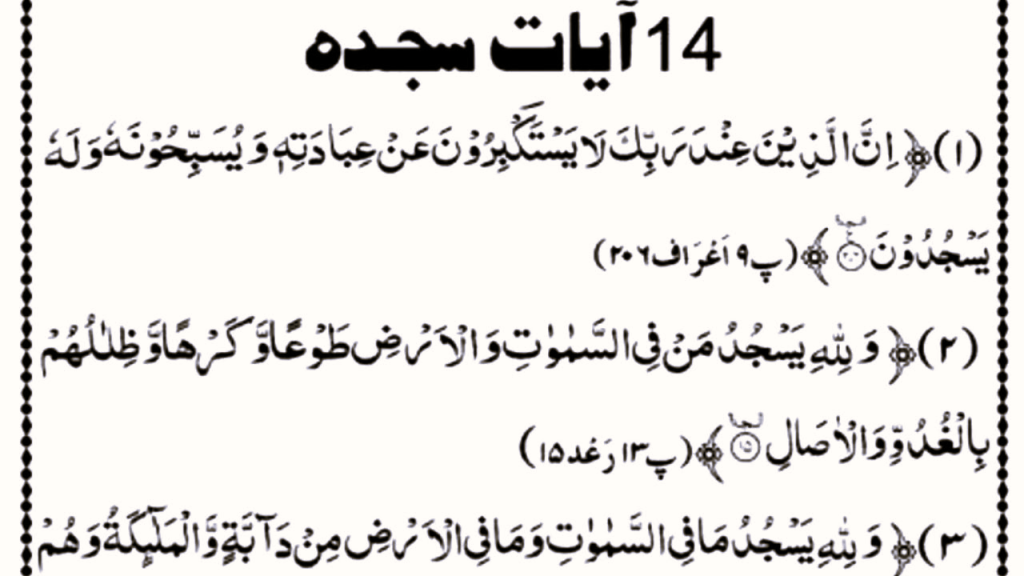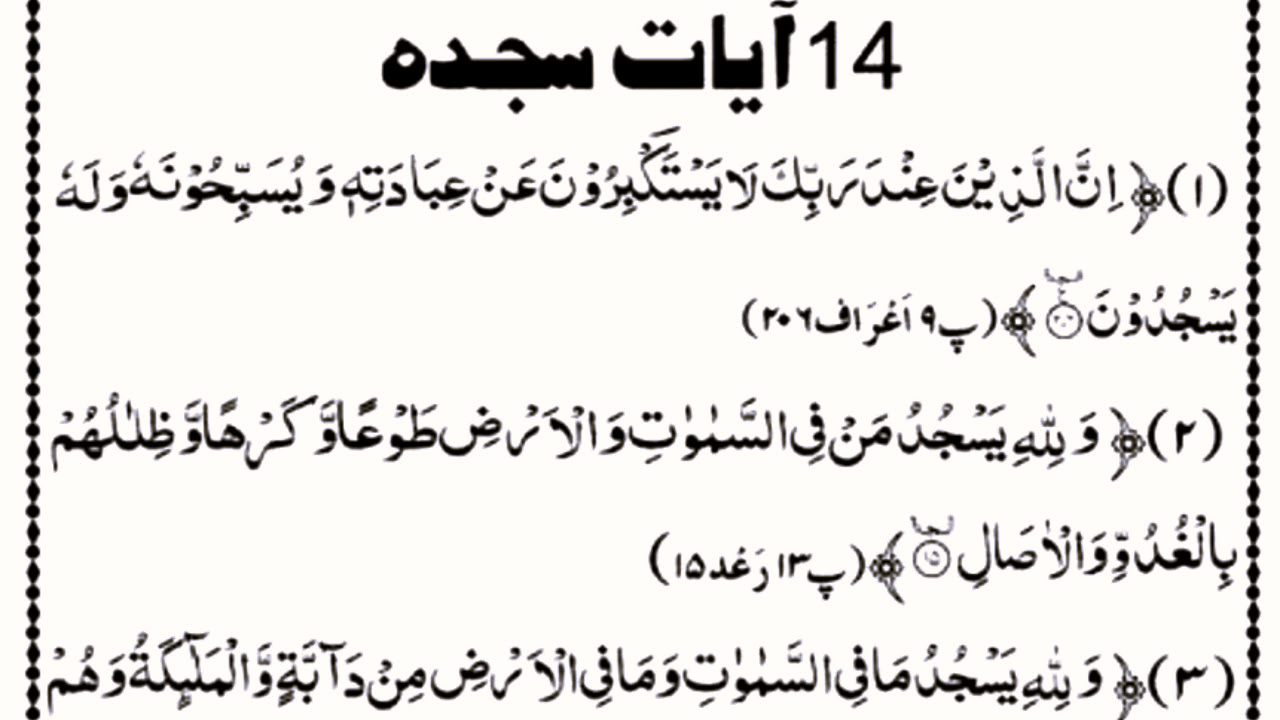List of Sajdah in Quran – Para Wise, Count, and How to Identify
Assalamualaikum, friends! Today’s topic is a little related to the heart – we are talking about Sajdah present in the Holy Quran. Many people know that Sajda takes place during Tilawat, but we get a little confused in the details. Today I am going to share with you everything that a common Muslim should know about Tilawat Sajdah.

Sajdah in Quran – How many are there?
This question often confused me also: How many Sajdahs are there in the Quran? Sometimes I hear there are 14; sometimes someone says there are 15. After doing some research and asking some scholars, I came to know that actually 14 Sajdah recitations are commonly accepted in the Quran. Yes, one extra Sajdah is also mentioned in Surah Al-Hajj, where there is Sajdah at two places—that is why some people say the total is 15. But most of the scholars’ and the world’s consensus is that 14 Sajdahs are standard.
It is a simple matter, but until one understands it, a little confusion remains. So let us share the complete list in this article—paragraph-wise, verse-wise—so that the matter becomes clear.
How to Identify Sajdah in the Quran?
Often when people start reciting sajdah in the Quran for the first time, a basic question comes to their mind: “How to identify the verse of sajdah?” It is a very simple thing, but until you open the Quran itself, confusion remains.
When you reach a verse while reading the Quran where Sajdah recitation becomes mandatory, there is a small mark there – this is called the sign of Sajdah. This sign is usually a small **curved or half-circle mark**, or somewhere there is a straight written “سجدة ” or “Sajdah in Quran.”
Each print of the Quran can be slightly different. In some copies, the Sajdah sign is written separately in the margin after the ayat, while in some copies the Sajdah sign is given inside the ayat itself. But the common thing is that this sign reminds you to stop and do Sajdah.
One more thing that helps: in many Quran editions there is a footnote or commentary beside the verses containing Sajdah in the Quran that tells you that it is prescribed to perform Sajdah there.
If you are a beginner, start reading the Quran with Tafseer or a translation of the Surahs. This will not only help you understand the verses of Sajdah but also their context.
Is it farz (obligatory) to do Sajdah in Quran or Sunnat?
This question often comes to people’s minds when they recite the Holy Quran: Is prostration obligatory or Sunnah? The answer is a bit simple and easy to understand.
Actually, Sajdah of Tilawat is neither obligatory nor mandatory if it is not done at such a level that one gets sins. Rather, it is mustahab, that is, it is a good thing, it is Sunnat. If you do Sajdah, then you get rewards, and if you miss it due to some reason then no sin is written on you.
But this does not mean that it should be ignored. Sahaba Kiram and elders always performed Sajdah with dignity. Whenever they came across a verse in the Quran where Sajdah in quran was written, they would immediately fall into Sajdah. Why? Because this is a way of bowing down before Allah – of acting upon the message of the Quran.
Nowadays we miss a lot of things in our busy life, but if you are praying and the need for Sajdah comes, then stopping for a while and doing Sajdah is a small prayer but its reward is great. This is hearing, but every hearing from the heart becomes a new light.
Method of reciting Sajdah
- When the verse of Sajdah comes, stop.
- If you are a man, then do wuzu.
- Saying “Allahu Akbar”, go into Sajda.
- Read “Subhaana Rabbiyal A’laa” 3 marba in Sajda.
- Get up without salam – this is not Namaz.
Verses of Sajdah in Quran – Para Wise Easy List
Friends, if you want to understand Sajdah in quran Wali Ayaat para wise, then this list is useful for you. But not just numbers – I am telling you small things also so that remembering becomes easy.
- Surah Al-A’raaf (Para 9), Ayah 206: This is the first Sajdah, where angels prostrate themselves. This verse has a wonderful meaning.
- Surah Ar-Ra’d (Para 13), Ayah 15: Everything is prostrated before Allah – this verse reminds us of the worship of nature.
- Surah An-Nahl (Para 14), Ayah 26: The mention of the cruel people and the power of Allah – prostration means the time to bow down before Allah.
- Surah Al-Isra (Para 15), Ayah 109: When people recite the Quran and prostrate themselves – their hearts tremble after listening to this.
- Surah Maryam (Para 16), Ayah 58: Remembering the Prophet and performing his prostration is a lesson.
- Surah Al-Hajj (Para 17), Ayah 18: First prostration is in Surah Hajj – here all creatures are in prostration.
- Surah Al-Hajj (Para 17), Ayah 77: Second prostration is in the same Surah – for this reason some people perform 15 prostrations.
- Surah Al-Furqan (Para 19), Ayah 60: When people say that Allah Prostrate yourself, and they deny it – there is sorrow.
- Surah An-Naml (Para 19), Ayah 26: There is no god except Allah – prostrate yourself only to Him.
- Surah As-Sajda (Para 21), Ayah 15: This is a surah of prostration – its name is given to it.
- Surah Sad (Para 23), Ayah 24: The incident of Hazrat Dawood – their prostration gives a lesson.
- Surah Fussilat (Para 24), Ayah 38: If people prostrate themselves If you deny it, it makes no difference to Allah.
- Surah An-Najm (Para 27), Ayah 62: This Sajda is also Sunnat – this Sura is also recited in Namaz.
- Surah Inshiqaq (Para 30), Ayah 21: Last Sajda – a reminder of the end of the prayer with the foot.
So friends, in this way there are total 14 Sajdahs in Quran which are commonly accepted. Due to 2 Sajdas in Surah Hajj, sometimes the count becomes 15. But this list will help you in remembering paragraph wise, InshaAllah.
2nd Sajdah in Quran in Which Para?

One unique thing is that there are 2 Sajdahs in Surah Al-Hajj. Both of them come in the 17th paragraph – Ayah 18 and 77. For this reason sometimes people count as 15.
Spiritual Impact of Sajdah in quran
When a person does Sajdah in quran, he does not just put his head on the ground – he surrenders everything to Allah. This Sajdah in quran is actually an expression of self-realization before Allah. This is a condition where a person’s arrogance, his ego, his worldly worries, everything vanishes. Only the person and his God remain.
Sajdah in quran is that moment when there is a direct connection between the soul and God. When you do Sajda, a strange kind of coolness descends on your heart – a peace that cannot be expressed in words. The same Sajda that is obligatory in Namaz becomes a Muslim during Tilawat, but its spiritual effect is that much deeper.
Some people have said that the turning point of their life came during Sajda – when they cried, prayed, and their heart became light. Sajda is not just a physical act, it is a spiritual journey. And when a person bows before Allah, he actually stands up – in glory, in light, and in peace.
FAQs – Sajdah in Quran
1. How to perform sajdah in quran and Tilawat?
Sajdah Tilawat is the Sajda that is done after reading or listening to any such verse of Quran where there is a command of Sajdah, This is a Sunnat Amal that gives us the message of bowing before Allah, Both the one who is reading and the one who is listening can do Sajda.
2. Can We Sajdah Tilawat be done without wuzu?
It is better to do Sajdah with wuzu, but if at some time wuzu is not important then Sajda can still be done. Taharat is afzal, but Sajda is considered even without wuzu.
3. How many Sajdas are there in Quran?
Generally there are 14 Sajdah in Quran. But there are 2 Sajdas in Surah Al-Hajj – one in Ayat 18 and the other in Ayat 77, both in Para 17. That is why some people say total 15 Sajdas.
4. Is Namaz necessary for doing Sajda?
Sajdah Tilawat is not a part of Namaz, It is done separately. When the Ayat of Sajdah comes, you can do Sajda even without Namaz.
5. In which part of Quran there are more Sajdah verses?
If you look at Quran then most of the Sajdah verses are found in middle paragraphs, especially between paragraph 13 to 30. In these verses there is a deep message of bowing before Allah.
6. If Sajdah is not done after listening to Sajdah verse then what is the sin?
If you do not do Sajdah after listening to Sajdah verse then it is not a sin. But if life is given up knowingly then it is like giving up the good deed. It is better to do it and it also creates reward.
7. If the same verse containing Sajdah is heard again, is it necessary to do Sajdah in quran again?
Yes, if you hear the same verse again in which there is a command of Sajdah, then it is necessary to do Sajdah every time. Yes, if there is no place or time, then it is justified to leave it, but doing it is better.
A message from the heart
Friends, the Quran is the message of Allah – not just for recitation, but for thinking, understanding and bringing it into life. There is a hidden wisdom in every verse and a new connection in every prostration. When we prostrate, we talk to our Lord not just with words, but with our whole heart.
This prostration seems like a small action, but its effect is deep inside the heart. Those who experience Sajdah, their faith shines with a new light. Sajdah in quran is a simple but powerful call of the Quran – an invitation to “Stop, bow down, and meet Allah.”
If you are reading this article today, then this is also a way of Allah to remind you. Don’t just stop reciting the Tilawat. Wherever Sajdah in quran comes, stop there. Take some time and bow down. Because it is possible that in Sajdah you will find such peace which the whole world cannot give.
If this thing has touched your heart, then share this message with others. Maybe someone’s heart will bow down in prayer.

AoA, my name is Abd al-Rahman, and my vision is to spread the knowledge of the Quran to everyone. I am proud and tall while standing as your trusted mentor on the journey of learning and memorizing the Holy Quran. I, along with a committed team of Islamic teachers, am bound to provide an easy online facility for Islamic studies and Hifz programs.

